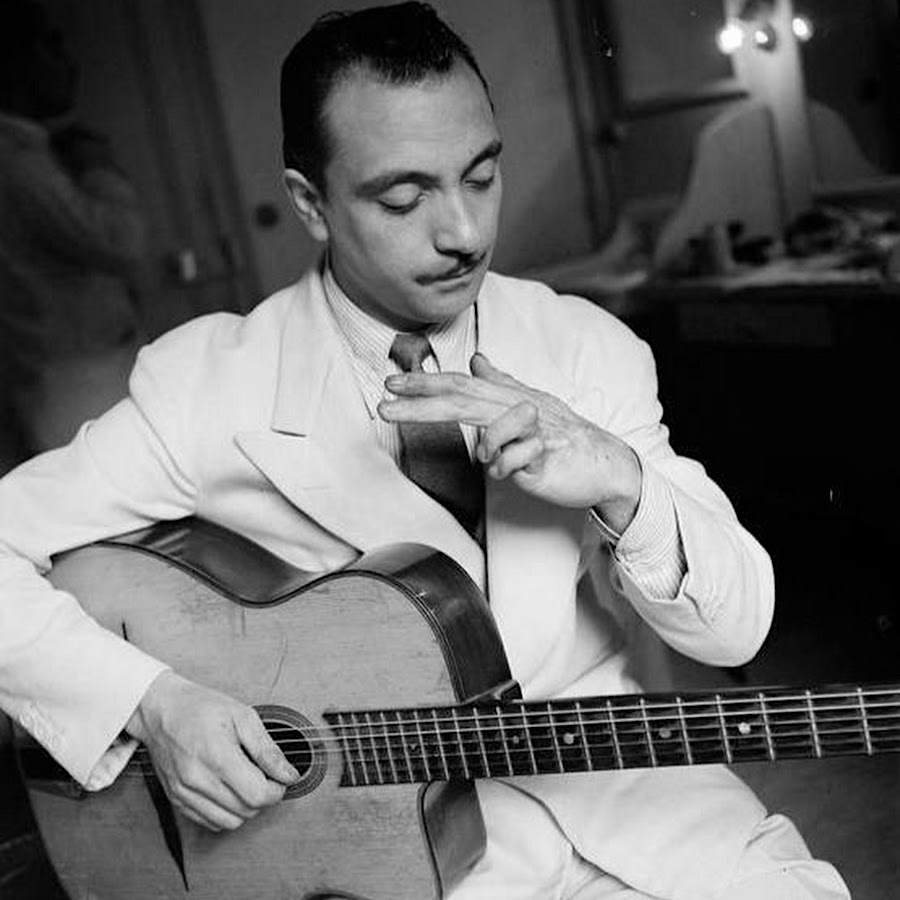
Jean Reinhardt, known to all by his Romani nickname Django, was a Belgian-born Romani–French jazz guitarist and composer.
He is considered as one of the greatest jazz musicians of the twentieth century and as the first major jazz talent to emerge from Europe.
On November 2, 1928, When Reinhardt was 18 years old, he and is wife badly burned in a fire. They both survived, but Django would spend the next 18 months recovering from terrible injuries. The two smallest fingers on his left hand–crucial to a guitarist for articulating notes on the fretboard–were paralyzed.
Reinhardt overcame the limitation by inventing his own method of playing. With his two good fingers he moved rapidly up and down the guitar neck while making very limited use of his two shriveled fingers on chords, double-stops and triple-stops. He rose above his handicap to created one of the most distinctive instrumental styles in 20th century music.
For a rare look at Reinhardt’s amazing technique, watch the excerpt above from the 1938 short film, Jazz “Hot”. It features Reinhardt with violinist Stéphane Grappelli and their band, Quintette du Hot Club de France, playing a swing version of the popular song “J’attendrai”.
From 1934 until the outbreak of World War II in 1939, Reinhardt and Grappelli worked together as the principal soloists of their newly formed quintet, the Quintette du Hot Club de France, in Paris. It became the most accomplished and innovative European jazz group of the period.
Reinhardt also played and recorded with many American jazz musicians, such as Adelaide Hall, Coleman Hawkins, Benny Carter, and Rex Stewart (who later stayed in Paris).
The Second World War
While he tried to continue with his music, war with the Nazis presented Reinhardt with two potentially catastrophic obstacles. First, he was a Romani. Second, he was a jazz musician.
During the war, Romani were systematically killed in concentration camps.
Hitler and Joseph Goebbels viewed Jazz as un-German counterculture and Goebbels stopped short of a complete ban on Jazz, which now had many fans in Germany and elsewhere. Official policy towards Jazz was much less strict in occupied France – A new generation of French Jazz fans, the Zazous, had arisen and swollen the ranks of the Hot Club.
Reinhardt was the most famous jazz musician in Europe at the time, working steadily during the early war years and earning a great deal of money, yet always under threat.
Reinhardt expanded his musical horizons during this period. Using an early amplification system, he was able to work in more of a big-band format, in large ensembles with horn sections.
Touring The United States
After the war, Reinhardt rejoined Grappelli in the UK. In the autumn of 1946, he made his first tour in the United States, debuting at Cleveland Music Hall as a special guest soloist with Duke Ellington and His Orchestra. Later on he played with many notable musicians and composers. At the end of the tour, Reinhardt played two nights at Carnegie Hall in New York City; he received a great ovation and took six curtain calls on the first night.

Returning To Europe
After the tour, Reinhardt secured an engagement at Café Society Uptown, where he played four solos a day, backed by the resident band. These performances drew large audiences. Having failed to bring his usual Selmer Modèle Jazz, he played on a borrowed electric guitar, which he felt hampered the delicacy of his style. He had been promised jobs in California, but they failed to develop. Tired of waiting, Reinhardt returned to France in February 1947.
After his return, had difficulties to adjust to the postwar world. He sometimes showed up for scheduled concerts without a guitar or amplifier, or wandered off to the park or beach. On a few occasions he refused to get out of bed. Reinhardt developed a reputation among his band, fans, and managers as extremely unreliable. He skipped sold-out concerts to “walk to the beach” or “smell the dew.” During this period he continued to attend the R-26 artistic salon in Montmartre, improvising with his devoted collaborator, Stéphane Grappelli.
Here you can hear “Minor Swing”, one of their most known tunes:
His Death
On 16 May 1953, while walking from the Gare de Fontainebleau–Avon Station after playing in a Paris club, he collapsed outside his house from a brain hemorrhage.
It took a full day for a doctor to arrive and Reinhardt was declared dead on arrival at the hospital in Fontainebleau, at the age of 43.
“Nuages”, one of Django’s best-known compositions:
Influence
Many guitar players and other musicians have expressed admiration for Reinhardt or have cited him as a major influence. Jeff Beck described Reinhardt as “by far the most astonishing guitar player ever” and “quite superhuman”.
Grateful Dead’s Jerry Garcia and Black Sabbath’s Tony Iommi, both of whom lost fingers in accidents, were inspired by Reinhardt’s example of becoming an accomplished guitar player despite his injuries.
Tony Bennett perfroming “All of You”, a song he wrote using the music of “Nuages”
We’ll finish the book with the great Willie Nelson, a lifelong Reinhardt fan, performing “Nuages”
The information in the E-book is mostly based on: https://en.wikipedia.org/wiki/Django_Reinhardt
Published: Dec 15, 2020
Latest Revision: Dec 15, 2020
Ourboox Unique Identifier: OB-965919
Copyright © 2020








